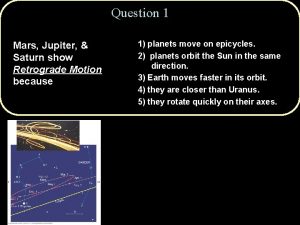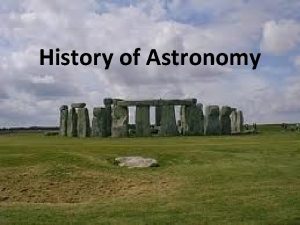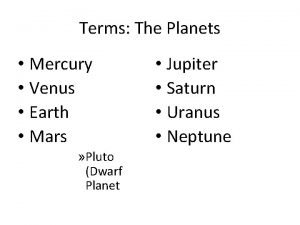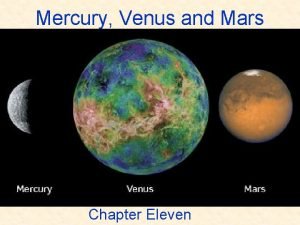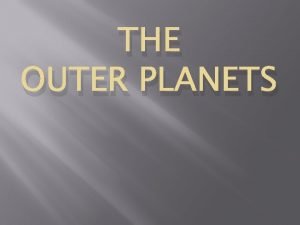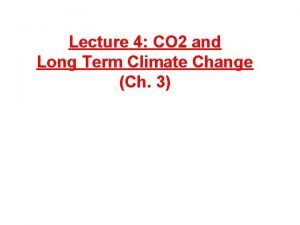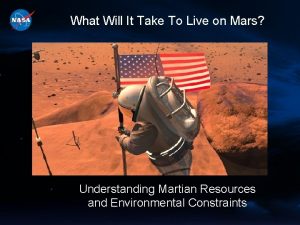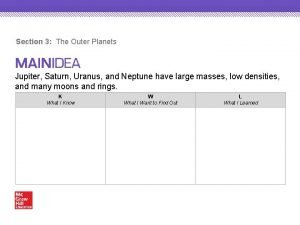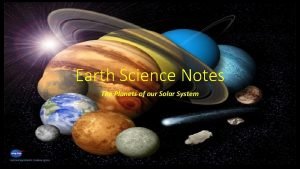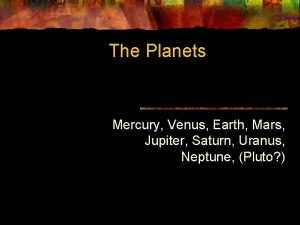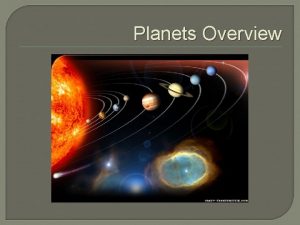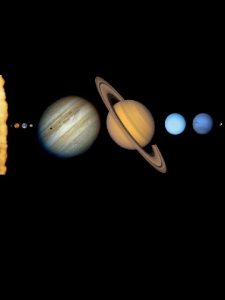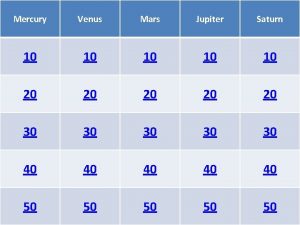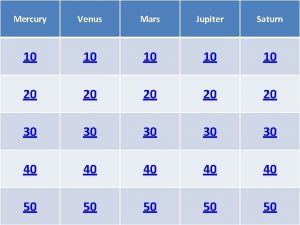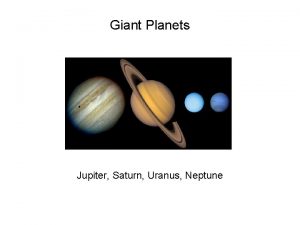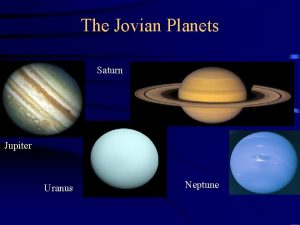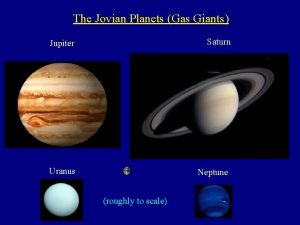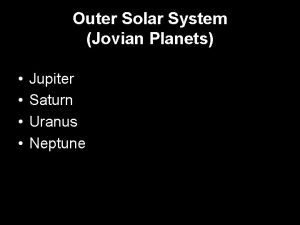Planets Mercury Venus Earth Mars Jupiter Saturn Uranus
















- Slides: 16

Planets Mercury, Venus, Earth, Mars, Jupiter, Saturn, Uranus, Neptune Lunar and Solar Eclipses

Planets

Planet Groups • The Inner Planets – Planets closest to the Sun • • Mercury Venus Earth Mars Pluto? ? ? The Outer Planets far from the Sun § Jupiter § Saturn § Uranus § Neptune

Mercury • • Planet closest to the Sun Smallest Terrestrial Planet Has no moons of its own Why would it have extreme temperatures ? It is very close to the Sun • 1) ______________ It has NO atmosphere • 2) ____________

Venus • Can be seen in the west just after sunset or in the morning sometimes. • Is also called the “evening or morning star” even though it is not a star. • Similar to Earth in size and mass and is called the Earth’s twin • Has the hottest surface of all the planets because of the greenhouse effect

Mars • Called the “Red planet” due to the iron rich rock (Rusty) • Mars is quite cold due to – 1) Its thin atmosphere – 2) Its distance from the Sun

Planets

Outer Planets – The gas giants • All the gas giants have thick atmospheres • Outer layers of the gas giants are extremely cold due to the distance from the Sun • All the gas giants have moons • They also have RINGS – thin disks of small particles of ice and rock.

Jupiter and Saturn • Jupiter • The largest and most massive planet • Has 4 moons • Saturn • The 2 nd largest planet • Has the most spectacular rings around it

Uranus , Neptune & Pluto? ? ? • Uranus • Looks blue-green in color because of the methane in the atmosphere • Neptune • Is a cold, blue planet • Its atmosphere contains visible clouds. Pluto – A Dwarf Planet Because it has not cleared out the neighborhood around its orbit. Has a solid surface Is smaller & denser than the outer planets

Eclipses – Where R U ? • Eclipses occur when the shadow of an object in the sky (ex. Moon, Earth) falls on another object • Two types of Total Eclipses: – Lunar Eclipse – Moon is hidden – Solar Eclipse – Sun is hidden

Lunar Eclipse – Moon is hidden – Occurs when the Moon passes through a part of the Earth’s shadow. – The shadow caused by an eclipse is an UMBRA – The moon appears red as it receives some light reflected off the Earth. – Happens at night

Next Lunar eclipse in US • April 14 -15 th in 2014

Solar Eclipse – Sun is hidden Next in US on August 17 th, 2017 • Occurs at New moon, when the Moon passes between the Sun and the Earth • Happens during the day.

Corona • The outer atmosphere of the Sun is called the Corona. • It is the only part of the Sun seen during a total eclipse. • Solar eclipses can cause serious damage to the eyes if observed directly.

Answer these questions Astronomy Test next class • • 1) Which planets make up the inner planets? 2) Which planets make up the outer planets? 3) Name 4 characteristics of the outer planets? 4) Give two differences between rotation and revolution. • 5) Name the different phases of the moon and write a sentence on each. • 6) What is the order of planets? • 7) Come up with an acronym for YOU to remember the order of the planets.
 Mars, jupiter, and saturn show retrograde motion because
Mars, jupiter, and saturn show retrograde motion because Mars, jupiter, and saturn show retrograde motion because
Mars, jupiter, and saturn show retrograde motion because Earth mars pluto venus
Earth mars pluto venus The two outer jovian planets appear bluish in color because
The two outer jovian planets appear bluish in color because Neptun saturn
Neptun saturn Mercury planet
Mercury planet Mercury venus
Mercury venus What are the four outer planets called
What are the four outer planets called How are terrestrial planets different from jovian planets?
How are terrestrial planets different from jovian planets? What separates the inner planets and outer planets
What separates the inner planets and outer planets The inner solar system by leslie
The inner solar system by leslie Inner planets and outer planets
Inner planets and outer planets Characteristics of outer planets
Characteristics of outer planets Venus vs earth
Venus vs earth Mars and earth size comparison
Mars and earth size comparison Uranus was discovered accidentally in 1781
Uranus was discovered accidentally in 1781 Uranus planeet
Uranus planeet
